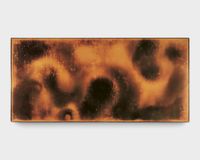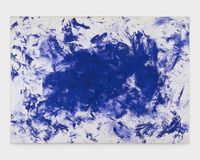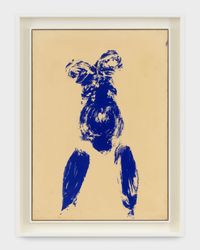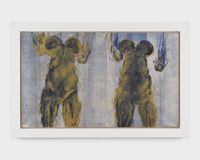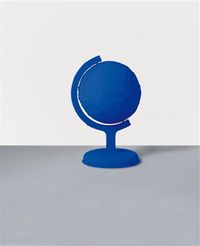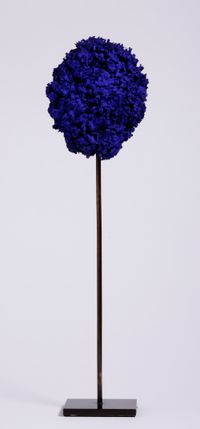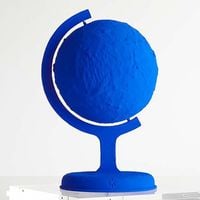Yves Klein was a French artist linked to the Nouveau réalisme group of artists marshalled together by the critic Pierre Restany. Klein combined mysticism, conceptual art, and showmanship in his exploration of intensely saturated colours, ritualistic actions, and symbolic materials to make a wide range of distinctive paintings, sculptures, and explanatory documents.
Read MoreFrom an early age, Klein was exposed to a wide range of art genres and practitioners socially. His parents, Fred and Marie, were both painters, one figurative, the other abstract expressionist. Klein had no formal art training. From 1942 to 1946, he studied at the École Nationale de la Marine Marchande and the École Nationale des Langues Orientales. At the latter, he took up judo and became very good at it. In the late 1940s, he travelled through Europe, and in 1953 went to Japan, where at 25 he became a master at judo. In 1954, however he decided to make art his career.
Klein held his first exhibition of monochromes In 1950, and then two more shows in Paris five years later featuring five colours. Because his audience did not apprehend the colours individually, instead viewing them as a kind of mosaic, he decided to concentrate only on blue. Due to the judo, he also became interested in Zen Buddhism, ritual acts, and the notion of emptiness.
In 1957 in Milan's Galerie Apollinaire, he presented 11 identical ultramarine canvases featuring an especially radiant pigment, what he called International Klein Blue. To increase spatial ambiguity they were positioned on poles 20 centimetres out from the wall.
Klein believed that art is everywhere that the artist goes and that while beauty is invisible, the artist must attempt to capture it to encourage gallery goers to see with their imaginations. He regarded monochrome painting as an 'open window to freedom, as the possibility of being immersed in the immeasurable existence of colour.' These works gave access to the infinite, to immateriality, as seen in Untitled Blue Monochrome (IKB 191) (1962).
In a Paris exhibition at Iris Clert in 1957 he released 1001 blue balloons and blue postcards that were sent with IKB 'stamps'. The following year, he emptied the Clert gallery and its large cabinet, painted the walls white and the windows blue, put up blue curtains, brought in guards, and served blue cocktails. 3000 people queued up for the opening.
The next year, in an opera house in Gelsenkirchen, Germany, Klein showed a group of massive 7-x-20-metre murals made of IKB and soaked sponges. He often picked sponges to apply the paint, and in the 'Anthropometry' series (1960), naked women used their bodies as 'living brushes' on rolls of paper on the floor and wall.
Klein was skilled in attracting media attention. In Leaping into the Void (1960), Klein exploited a faked photograph of him diving headfirst out of a first floor window, the image of a safety tarpaulin held by friends later removed.
In his quest for memorable symbols of elemental spirituality he also used water and fire from blowtorches. He made flaming sculptures and burnt paintings, as in Untitled Fire Painting (F18) (1961), and also used burnt receipts for negative fiscal transactions with gold leaf, seen in Zones of Immaterial Pictorial Sensibility (1961).
Yves Klein has featured in both solo and group exhibitions. Solo exhibitions include Traces: Yves Klein, Platforms Projects, Paris Art Fair (2021); Focus: Yves Klein, Opera Gallery, Paris (2021); Yves Klein: The Venus Project, Galerie Gmurzynska, Zurich (2020); Yves Klein: A Career Survey, Lévy Gorvy Gallery, New York (2005).
Recent Group Exhibitions include Meta Visceral, Lévy Gorvy Gallery, New York (2021); Colour in Contextual Play: An Installation by Joseph Kosuth / Neon in Contextual Play: Joseph Kosuth and Arte Povera, Mazzoleni, Torino (2017); A Bigger splash: Painting After Performance, Tate Modern, London (2013).
Yves Klein's work is held in major collections around the world, including Fondation Louis Vuitton; Solomon R. Guggenheim Museum, New York; Walker Art Centre, Minneapolis; Archives Yves Klein, Paris.
Yves Klein's website can be found here. The Yves Klein Archives Instagram can be found here.
John Hurrell | Ocula | 2021
